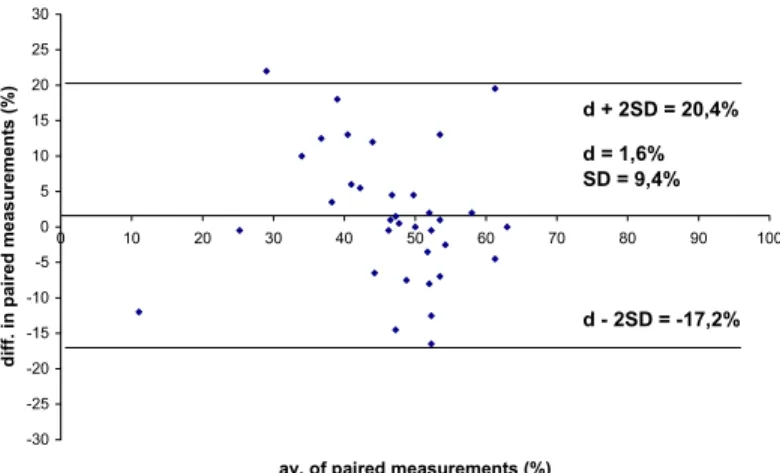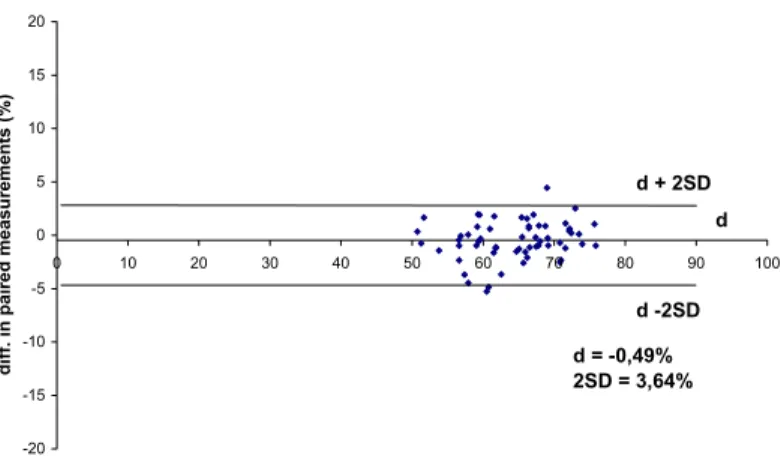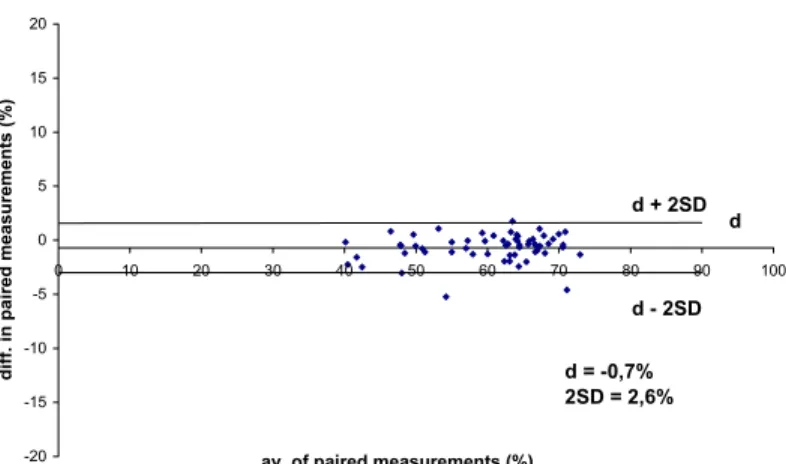DOCTORAL (PhD) THESIS
UNIVERSITY OF WEST-HUNGARY
FACULTY OF AGRICULTURAL SCIENCES, MOSONMAGYARÓVÁR Institute of Animal Breeding
Program leader and supervisor:
DR. DR. h.c. JÁNOS IVÁNCSICS MHA
CYTOLOGICAL INVESTIGATIONS ON BULL SPERMATOZOA
By:
SZABOLCS T. NAGY
MOSONMAGYARÓVÁR
2001
1. BACKGROUND AND AIMS OF THE STUDY
Good sperm quality is essential for the success of artificial insemination. During routine analysis of sperm quality, concentration, percentage of motile spermatozoa and sperm morphology are the commonly investigated attributes. However, high correlations are rarely found between the results of these laboratory tests and field fertility. The complexity of fertilization requires simultaneous evaluation of several spermatozoan attributes.
A possible candidate for multiparameter sperm analysis is the staining method of Kovács and Foote (Biot Histoc 67: 119-124., 1992).
The aims of this study were to:
• investigate the applicability of the live/dead and acrosome staining of Kovács and Foote for studying the plasma membrane integrity of the sperm tail,
• determine the relationship between the sperm tail staining and motility,
• validate the live/dead and acrosome staining with flow cytometric measurements,
• develop a new, flow cytometric live/dead and acrosome staining combination for routine analysis of semen processed in egg yolk-based extenders.
2. MATERIALS AND METHODS 2.1. Sperm tail membrane staining under hypoosmotic conditions
For combining the vital staining and HOS we followed the modified method of Kovács and Foote (1992): we used a hypoosmotic trypan blue solution. We checked the smears at 400x magnification under light microscope.
2.2. Comparison of sperm tail staining and Computer-Assisted Semen Analysis (CASA)
2.2.1. Membrane integrity
From frozen/thawed semen samples we made stained smears following the method of Kovács and Foote (1992). We checked the smears at 400x magnification under light microscope and classified the cells according to the membrane status of the sperm head, tail and acrosome.
2.2.2. CASA
We measured the percentage of motile cells (MOT%) using a HTM 2000 motility analyzer (Hamilton Thorne Research, Beverly, MA, USA).
2.3. Comparison of light microscopic and flow cytometric membrane integrity studies
2.3.1. Light microscopy
We made stained semen smears according to the method of Kovács and Foote (1992).
2.3.2. Flow cytometry
In this study we used a FACSCalibur flow cytometer (Becton Dickinson, San José, CA,
2.4. Flow cytometric investigations on sperm membrane integrity by a new fluorescent staining method
In the case of FITC-PNA/PI-stained samples we collected data on 10 000 "sperm"
events, while in the case of SYBR-14/PE-PNA/PI (SPP) stained samples we collected data on 10 000 "sperm AND NOT egg yolk" events.
To study the repeatability of the SPP method we used two ejaculates of each of ten bulls. We measured three straws per sample in two repetitions.
To determine the measurement bias due to egg yolk particles, we made paired measurements on 14 frozen/thawed semen samples using FITC-PNA/PI and SPP staining. We took measurements immediately after thawing ("0 hr") and after incubating the samples at 37°C for three hours ("3 hrs").
3. RESULTS
3.1. Sperm tail membrane staining under hypoosmotic conditions
The correlation coefficient found between the % of sperm with stained tails and the % with straight tails was 0.81, 0.94 (p<0,05) and 0.85 (p>0,10) for bull, ram and boar spermatozoa, respectively.
3.2. Comparison of sperm tail staining and Computer-Assisted Semen Analysis (CASA)
3.2.1. Method agreement analysis
The mean of the differences (d) was 1.6%, SD was 9.4%, 95% limits of agreement were d ± 2SD = (-17.2; 20.4%) (Figure 1.).
-30 -25 -20 -15 -10 -5 0 5 10 15 20 25 30
0 10 20 30 40 50 60 70 80 90 100
av. of paired measurements (%)
diff. in paired measurements (%)
d + 2SD = 20,4%
d - 2SD = -17,2%
d = 1,6%
SD = 9,4%
Fig. 1. Method agreement analysis of the Kovács-Foote staining and CASA.
3.3. Comparison of light microscopic and flow cytometric membrane integrity studies
3.3.1. Repeatabilities
The average difference between the repeated counts on stained smears (d) was 1.35%, SD was 5.09%, the British Standard Institution repeatability coefficient (2SD) was 10.18%. ( Figure 2.).
-15 -10 -5 0 5 10 15 20
0 10 20 30 40 50 60 70 80 90 100
diff. in paired measurements (%)
d = 1,35%
2SD = 10,18%
d + 2SD
d - 2SD
-20 -15 -10 -5 0 5 10 15 20
0 10 20 30 40 50 60 70 80 90 100
av. of paired measurements (%)
diff. in paired measurements (%)
d d + 2SD
d -2SD d = -0,49%
2SD = 3,64%
Fig. 3. Repeatability of the FITC-PNA/PI staining.
The average difference between repeated flow cytometric measurements (d) was – 0.49%, SD was 1.82%, the British Standard Institution repeatability coefficient (2SD) was 3.64%. ( Figure 3.).
3.3.2. Method agreement analysis
The mean of the differences (d) was 2.95%, SD was 5.7%, 95% limits of agreement were d ± 2SD = (-7.19; 13.09%) (Figure 4.)
-20 -15 -10 -5 0 5 10 15 20
0 10 20 30 40 50 60 70 80 90 100
av. of paired measurements (%)
diff. in paired measurements (%)
d = 2,95%
SD = 5,7%
d +2SD = 13,09%
d - 2SD = -7,19%
Fig. 4. Method agreement analysis of the Kovács-Foote and FITC-PNA/PI staining.
3.4. Flow cytometric investigations on sperm membrane integrity by a new fluorescent staining method
Four quadrants were set on the FITC-PNA/PI and SPP cytograms (Figure 5.)
Fig. 5. FITC-PNA/PI and SPP cytograms. Quadrants showed the following sperm cell subpopulations:
1. " live cells with intact acrosome"
2. "live cells with damaged/reacted acrosome"
3. "dead cells with intact acrosome"
4. "dead cells with damaged/reacted acrosome"
The average difference between repeated flow cytometric SPP-measurements (d) was - 0.7%, SD was 1.3%, the British Standard Institution repeatability coefficient (2SD) was 2.6%, indicating a high repeatability. ( Figure 6.).
-20 -15 -10 -5 0 5 10 15 20
0 10 20 30 40 50 60 70 80 90 100
av. of paired measurements (%)
diff. in paired measurements (%)
d + 2SD d
d - 2SD
d = -0,7%
2SD = 2,6%
Fig. 6. Repeatability of the SPP staining
Measurements by FITC-PNA/PI were on average 6.3 % larger than measurements by SPP (SD was 4.65%). The difference between the paired measurements became larger after a 3-hour long incubation at 37°C. (d 0 hr = 4.21%, d 3 hrs = 8.44%).
4. NEW SCIENTIFIC RESULTS
1. Spermatozoa with an intact head membrane, but a stained tail membrane should be included in the dead category in live/dead studies with vital stains.
2. The staining method of Kovács and Foote showed an acceptable repeatability and good agreement with the flow cytometric measurements.
3. I have developed a new, flow cytometric live/dead + acrosome staining combination for routine analysis of semen processed in egg yolk-based extenders.
5. SUGGESTIONS
Visual motility estimations are still acceptable for the quality assessment of fresh bull sperm. However, for the quality control of processed, frozen/thawed semen more detailed analyses are needed. Using multi-parametric methods, semen processing steps can be controlled as well.
A good starting point would be the establishment of a flow cytometer laboratory for animal reproductive biology studies.
6. SELECTED PUBLICATIONS 1. Scientific articles
1.1. Articles in Hungarian
• Iváncsics János – Nagy Szabolcs: Különböző fajtájú bikák spermium-defektusainak vizsgálata (előzetes közlemény) – Acta Agronomica Óváriensis, 1997., vol. 39., Num. 1-2., 67-75. (Examination of sperm defects in bulls of various breeds)
• Iváncsics János – Nagy Szabolcs: Különböző fajtájú bikák ondósejtjeinek ivari dimorfizmus-vizsgálata (előzetes közlemény) – Acta Agronomica Óváriensis, 1997., vol. 39., Num. 1-2., 77-91. (Sexual dimorphism of sperm cells in bulls of various breeds)
1.2. Articles in English
• Sz. Nagy, G. Házas, Á. Bali Papp, J. Iváncsics, F. Szász, F. Szász Jr., A. Kovács and R.H. Foote:
Evaluation of sperm tail membrane integrity by light microscopy – Theriogenology, 1999., 52:1153- 1159.
• Sz. Nagy, A. Kovács, T. Zubor, Z. Zomborszky, J. Tóth and P. Horn: Evaluation of frozen/thawed deer spermatozoa: short communication – Acta Veterinaria Hungarica, 2001, in press.
2. Conference abstracts:
• Nagy Szabolcs – Házas Gábor: Magyar szürke bika mélyhűtött spermájának mikroszkópos értékelése – IV. Nemzetközi Környezetvédelmi Szakmai Diákkonferencia, Mezőtúr, 1998. július 1-3. 39. old. (Light microscopic investigation of the sperm quality of a Hungarian Grey bull)
• Bakainé Kelemen L. - Nagy Sz. - Bali Papp Á. - Iváncsics J.: A tárolás hatása a kansperma életképességére és az akroszóma integritására. XXVII. Óvári Tudományos Napok: Új kihívások a mezőgazdaság számára az EU-csatlakozás tükrében. Mosonmagyaróvár, 1998. Állattenyésztési Szekció I. köt. 208-212. p. (Effect of storage on boar sperm viability and acrosome integrity)
• Sz. Nagy, G.Házas, Ágnes Bali Papp, A. Kovács and J. Iváncsics: Stained sperm tails: dead or alive? – Association for Applied Animal Andrology, Inaugural Meeting, 23-24 November, 1998., Herceghalom,
• A. Bali Papp, Sz. Nagy, J. Ivancsics, A. Kovacs, T. Pecsi and J. Dohy: Comparison of viability and acrosome status of boar spermatozoa frozen in mini or maxi straws - 50th Annual Meeting of EAAP, 22- 26 August, 1999., Zurich, Switzerland, p.126
• Kovács A., Nagy Sz., Dohy J., Iváncsics J., Gergátz E., Szász F., Merész L., Szalai G., Révay T., P.
Tardy E., Tóth A., Gustavsson, I. és Lindblad, K.: Kísérletek garantáltan ivarorientált sperma előállítására. Kitörési Pontok a Magyar Állattenyésztésben – tudományos konferencia. Budapest, 1999.
november 24. Állattenyésztés és Takarmányozás, 48:654-655. (Experiments to produce guaranteed sex- oriented sperm)
• Nagy Sz., Kovács A., Szász F., Merész L., Sinkovics Gy. és Iváncsics J.: A rutin spermavizsgálatok fejlesztési lehetőségei. Kitörési Pontok a Magyar Állattenyésztésben – tudományos konferencia.
Budapest, 1999. november 24. Állattenyésztés és Takarmányozás, 48:660. (New ways for improving routine smen analysis)
• Sz. Nagy, L. Merész, J. Várszegi, F. Szász, J. Iváncsics and A. Kovács: Relationship between sperm membrane integrity and motility. 26th Annual Conference of the International Embryo Transfer Society, Maastricht, the Netherlands, January 8-12, 2000. Theriogenology, 53:204 abst.
• A. Kovács, R.H. Foote, Sz. Nagy, A. Boersma, W. Leidl, R. Stolla and U. Domes: Live/dead and acrosome staining of stallion spermatozoa. 14th International Congress on Animal Reproduction, 2-6 July 2000, Stockholm, Sweden, p.82.
• Bodó, Sz., Nagy, Sz., Baranyai, B., Gócza, E., Kovács, A.: Bull sperm quality evaluated with differential staining before and after swim up. International Conference of Reproductive Biology, Stará Lesná, Slovakia, September 1- 3, 2000.
• Sz. Nagy, X. Qi, J. Han, A. Kovács: Light microscopic investigations on frozen/thawed yak semen – a pilot study. Third International Congress on Yak (ICY), Lhasa, China, September 4-9, 2000. (invited lecture)
• T. Révay, X. Qi, E. P. Tardy, Sz. Nagy, J. Han, A Kovács, A. Tóth, A. Salgó: Experiments on sexing yak spermatozoa by fluorescent in situ hybridization using bovine Y-chromosome specific DNA probe.
Third International Congress on Yak (ICY), Lhasa, China, September 4-9, 2000. (invited lecture)
• Bodó Sz, Nagy Sz., Baranyai B., Somfai T., Gócza E., Kovács A.: Spermaminőség jellemzése swim up előtt és után. Állattenyésztés és Takarmányozás, 2000. 49. 6. 581-583. (Sperm quality before and after swim-up)
• Nagy Sz.: Experiences in multicolor flow cytometric sperm analysis. ALTA Flow Cytometry Workshop, ALTA Europe, Garnwerd, The Netherlands, December 18-19, 2000. (invited lecture).
3. Popular articles
• Nagy Szabolcs: Az utódok ivarának titka – Holstein Magazin, June 1997., V:2., p. 71. (Secret of the sex of the offspring)
• Nagy Szabolcs: A spermiumok morfológiai vizsgálatának szerepe a gyakorlatban – Holstein Magazin, December 1998., VI: 4., p. 32. (Role of sperm morphology studies in the routine)



